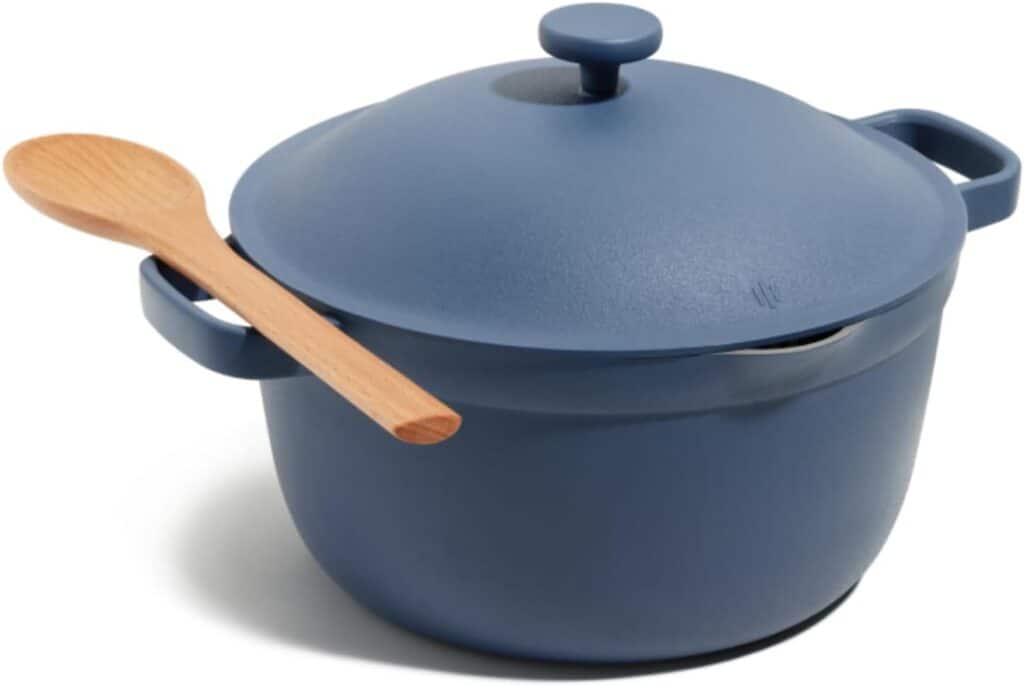This post may contain paid links. See more info on my privacy page.
My sugo sauce recipe, also known as Sugo di Pomodoro, is a rich and incredibly flavorful Italian tomato sauce recipe that brings out the best in simple ingredients. Best yet, it comes together in super simple steps and is perfect for making ahead.

Jump to:
Pomodoro Sauce
Today I'm here to share a true game changer of a recipe: Italian Sugo sauce! This classic homemade tomato sauce is so simple and so elegant, using only easy, delicious ingredients. Plus, I've included how to make tomato sauce from fresh tomatoes, making this the perfect way to use up a summer tomato surplus!
To start with, you need quality tomatoes. This is truly what sets Pomodoro sauce apart from other tomato sauce recipes. I always use San Marzano style tomatoes, which have a bright, acidic flavor that truly outshines other canned tomatoes. Trust me, they make a huge difference.
Then comes the secret weapon: dry wine (red or white; both are traditionally used) and a whole hour or more of gentle simmering! This is critical. Simmering the sugo sauce for a long time means the flavors start melding together- instead of getting two hits of flavor, tomato and then wine, you get it all at once in this glorious mix. Combined with how the sugars in the tomatoes start to caramelize, it's truly something you need to taste to believe!
Tools to Make Sugo di Pomodoro
- A Dutch Oven or other large, lidded soup pot - I love my dutch oven, which I've included below. You'll need something with a lid as this sauce needs to simmer for a very long time.
- A wooden spoon for stirring and crushing tomatoes.
- An immersion blender or food processor if you want a smooth sauce.

Isabel's Braising Pot
If you don't have a dutch oven already or want to treat yourself to a new pot for braising (and more!), I recommend the Perfect Pot. I love this pot so much, I basically use it for everything.
photo courtesy of Our Place on Amazon
Ingredients in Sugo di Pomodoro
- Extra Virgin olive oil: You can also use unsalted butter, as both butter and olive oil are traditionally used in Italy depending on the region.
- Onion: Yellow onion is ideal for sweetness.
- Garlic: Use fresh garlic cloves, as you'll want the freshest flavor possible.
- Whole peeled tomatoes: These are the most important part, so you'll want quality canned tomatoes. I prefer San Marzano style whole tomatoes and I try to get the nicest brand I can buy at the grocery store.
- Dry red wine or Dry white wine: The difference between red and white is in the depth of the fruit flavor. I prefer red wine, but both are excellent.
- Red pepper flakes
- Salt
- Black pepper
- Fresh basil: For sugo, it's important to use fresh basil! There really is a flavor difference and it becomes very apparent in long-simmered dishes like this one with simple flavors.
- Parsley

Using Fresh Tomatoes
You can make sugo with fresh tomatoes if you wish! However, you will first need to blanch and peel the tomatoes to ensure the peel doesn't mess with the texture of the sauce. With San Marzano tomatoes, you don't need to worry about it, as they've already been peeled.
To prep fresh tomatoes for sauce:
Step 1: Boil a large pot of water deep enough to fit all of the tomatoes. Once at a rolling boil, add the tomatoes and let them boil for 1-2 minutes.
Step 2: Remove the tomatoes and place them in a bowl of ice water to stop the cooking process, and let them rest for 1-2 minutes, or until cool enough to handle.
Step 3: Remove the tomatoes from the water and let them cool and drain, then peel off the loosened skins and cut out where the stem attached to the tomato.
Step 4: Slice the tomatoes in half and scoop out the jelly and seeds. The tomatoes are now ready for cooking! Note that if you're using cherry tomatoes or grape tomatoes, you don't need to core or seed them.
Note: If you want, you can freeze the tomatoes at this point and use them later. This is a great way to store excess tomatoes from a big summer harvest as they last great in the freezer.

Sugo di Pomodoro
Video
Equipment
Ingredients
- 2 Tablespoons Olive oil
- 1 small Onion - yellow or white, chopped
- 3 cloves Garlic - minced
- 28 oz. Whole peeled tomatoes - canned (San Marzano style)
- ½ cup Red wine
- 1 pinch Red pepper flakes
- 4 leaves basil - fresh, chopped and divided
- Salt - to taste
- Pepper - to taste
Instructions
- Heat 2 Tablespoons Olive oil in a large dutch oven over medium heat. Once hot, add 1 small Onion and 3 cloves Garlic. Saute for 3-5 minutes.2 Tablespoons Olive oil,1 small Onion,3 cloves Garlic
- Add 28 oz. Whole peeled tomatoes and stir to combine. If you prefer a less chunky texture, smash the tomatoes with the back of your spoon while cooking.28 oz. Whole peeled tomatoes
- Pour in ½ cup Red wine, and stir.½ cup Red wine
- Season with 1 pinch Red pepper flakes and 2 leaves basil, and stir again to combine.1 pinch Red pepper flakes,4 leaves basil
- Let the sauce simmer for 1 hour, stirring occasionally. The sauce can be left to simmer for longer for deeper flavor. Once it's ready, add the rest of the basil, and serve!
Notes
- If you find the sauce to be too acidic, you have a few options for sweetening it!
- Carrot: Add a carrot near the beginning of the cook time, cut into large chunks. Remove it before serving. This adds natural sweetness.
- Sugar: 1-2 teaspoons of white sugar will easily sweeten the dish. This is the easiest method for taste-testing until it's just right.
- Baking soda: Baking soda will raise the pH, making the sauce less acidic. Only use a tiny pinch, as you want the sauce to still have some bite!
- If you'd like, you can dice up carrots and celery and saute them with the onion to make a mirepoix. If you do this, make sure to blend the sauce or run it through a food processor as they will make the sauce chunky.
- The longer this sauce simmers, the better! You can even fully cover the pot and let it simmer slowly for upwards of 3-4 hours, making sure to stir now and then so the bottom doesn't burn. This will only deepen the flavor.
- You must use either fresh tomatoes or canned whole tomatoes. Canned tomato sauce, diced tomatoes, or bottled marinara sauce won't work as they don't have the same flavor or texture.
Nutrition

Hi, I'm Isabel! I've been sharing my recipes online, in cookbooks, and in TV specials since 2012. The most important thing to me is Sunday supper with my family, and inspiring togetherness with my recipes!
Read More
Sugo di Pomodoro Detailed Instructions
Step 1: Add the olive oil to your Dutch Oven or large soup pot over medium heat. Then add in the onion, and saute until starting to soften, about 3-5 minutes. In the last minute, add the garlic and stir it in until fragrant. Make sure not to add it right away, as it can stick to the bottom of the pot and burn.
Step 2: Add in the whole peeled tomatoes including the juices, and stir to combine. Depending on your preferences, you can choose to smash the tomatoes with the back of your wooden spoon, leave them whole, or even blend them with an immersion blender for a smoother or chunkier sauce.
Step 3: Add in the wine, red pepper flakes, and half the fresh basil, and give it all a good stir.
Step 4: Bring the sauce to a low simmer, and cover the pot with only a small crack left open to release steam. Simmer for one hour, stirring occasionally. You may need to add a little water if it reduces too fast.
Step 5: Right before it's done, chop up the remaining fresh basil leaves and add them to the sauce. This will add some of that bright, sharp fresh basil flavor alongside the more mellow, basil oil rich flavor of the cooked basil leaves.
Finishing: You can finish the sauce off with salt and pepper to taste, as well as freshly grated parmesan cheese. Serve with your favorite pasta, and enjoy!
Tips for Making Sugo
- If you find the sauce to be too acidic, you have a few options for sweetening it!
- Carrot: Add a carrot near the beginning of the cook time, cut into large chunks. Remove it before serving. This adds natural sweetness.
- Sugar: 1-2 teaspoons of white sugar will easily sweeten the dish. This is the easiest method for taste-testing until it's just right.
- Baking soda: Baking soda will raise the pH, making the sauce less acidic. Only use a tiny pinch, as you want the sauce to still have some bite!
- If you'd like, you can dice up carrots and celery and saute them with the onion to make a mirepoix. If you do this, make sure to blend the sauce or run it through a food processor as they will make the sauce chunky.
- The longer this sauce simmers, the better! You can even fully cover the pot and let it simmer slowly for upwards of 3-4 hours, making sure to stir now and then so the bottom doesn't burn. This will only deepen the flavor.
- You must use either fresh tomatoes or canned whole tomatoes. Canned tomato sauce, diced tomatoes, or bottled marinara sauce won't work as they don't have the same flavor or texture.
Homemade Tomato Sauce Storage
- Containers: Store tomato sauce in glass mason jars if possible. Tomato easily stains plastic containers. You can even seal this sauce in canning jars, but you'll need to add lemon juice to ensure it's acidic enough.
- Refrigerator: Homemade tomato sauce lasts up to 5 days in the fridge.
- Freezer: Freezing leftovers is the ideal way to ensure it stays fresh! Frozen tomato sauce doesn't lose flavor and keeps a great texture. I recommend freezing it in ice cube trays and then transferring the cubes to a freezer safe bag for easy thawing.
FAQ
Sugo and Marinara are both classic tomato sauces, and the difference mainly lies in the use of wine. Sugo has a high proportion of wine to other ingredients, making the flavor very forward.
While typically served with spaghetti or other pasta, I love using sugo in anything that uses tomato sauce! For example, it's excellent on homemade pizzas or lasagna, or makes the most flavorful meatball sub in the world.







Comments
No Comments